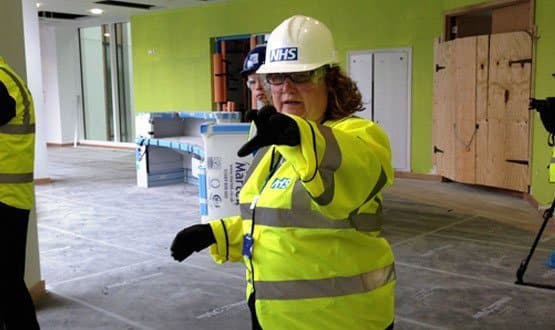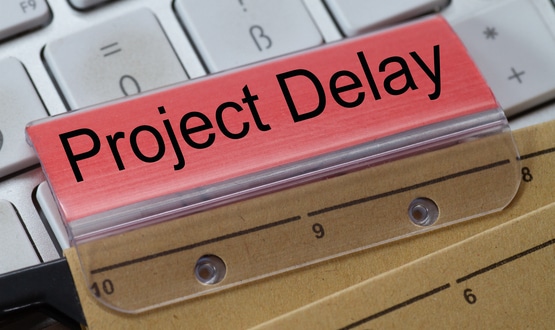Greenfield building site
- 13 June 2013

At North Bristol NHS Trust’s new hospital site, a media group gets a safety briefing before gearing up in steel-toed boots, high-visibility vests, and hard hats for a tour of the building.
The trust has been holding tours every year to show journalists how the new Southmead Hospital is progressing, but this one is special because it marks a year from the day when it will finally be open to staff and the public.
Looking up from the main reception area, floor to ceiling windows, warm wooden panels and a striking stone wall create a light and natural feel.
But on the unfinished wards it becomes clear how much work still needs to be done to make this hospital tick, as stretching down the long hallways are kilometres of cables, still exposed in the open ceiling.
Nurse Joanne Anyon, who is seconded full-time to work on the design of the new building, explains that it is future proofed for paperless working.
Tucked into the angle between each pair of rooms is a ‘bench area’ with power and data connections. The idea is that nurses will be able to sit and do referrals and electronic assessments on computers while also observing their patients on the ward.
"There’s lots of data points throughout the building," says Anyon. "We’ve kind of overdone it because we’re future proofing. So when we get to a stage where an observation machine can plug in and centrally download information, the idea is that we have the data points to do that.”
Behind the scenes, the trust’s IT team of around 200 staff is juggling 50 IT projects for the new hospital. One of the most significant of these is moving the Cerner Millennium electronic patient record from the old hospital structure to the new, which has new processes and clinics.
A bit of history
North Bristol was the last of three ‘greenfield’ sites in the South of England to deploy Millennium as part of an NPfIT contract with BT (which took over after Fujitsu quit as local service provider in 2008).
The trust went live with the system in December 2011, triggering a series of issues in outpatients and theatres, including patients being booked into non-existent appointment slots and appointment letters not being sent out.
An independent review of the deployment, commissioned by the trust and carried out by PricewaterhouseCoopers, concluded that North Bristol went live with Millennium before the outpatient or theatre builds were complete.
This sparked a “crisis” that took five months and £4.6m to resolve. Since then, the trust has been working to get back to ‘business as usual’, which interim head of IT Mike Brooks says it has now achieved.
"When I arrived in August we were still in a bit of a state of shock. [Former IT director] Martin [Bell] was moving on, we had data quality issues, and people’s use of the system was not what it should have been because they didn’t know how to use it properly."
The trust instituted a Cerner recovery project, which involved tracking a number of measurables for data quality and reporting back to the trust chief executive and medical director each week.
It has since resumed reporting into what was the strategic health authority. Reports had been frozen for some time because of poor data quality.
A "surge of activity" involved putting numerous additional people on site to give support on the wards and clinics to help resolve problems. The trust did one-on-one training and classroom catch-up sessions to help staff get to grips with the system.
Staff surveys were carried out last September, when the recovery project first started, and again in December, and these showed a 5-10% improvement in people’s perception of Millennium .
Brooks explains that the plan at this point was to have most of the EPR deployed in time for the new building. However, following the serious problems with phase one of the implementation, the trust chose to halt any further deployments.
It now has the Millennium patient administration system, A&E, theatres and a level of clinical documentation installed. A significant number of nursing assessments are done using the electronic system.
Looking ahead
North Bristol’s national contract expires in October 2015. It recently went out to procure a PAS/EPR and got ten responses.
"It’s no reflection on Cerner and what it can offer, but we are going into the procurement for beyond 2015 with a completely open mind. We know that if we did go for Cerner it would be different to what we have today," Brooks says.
The trust is looking for a direct replacement for what it has, but with the capability to grow into a fully bundled solution providing the ‘Clinical 5’ (a suite of clinical functionality defined five years ago to engage clinicians, as it became obvious that the national programme was going to be late, or not deliver at all).
"Going forward, we want a best-of-breed strategy. So as and when we want to do something clinical, we will either look to our main product or look to buy off-the-shelf or to develop in-house," Brooks explains.
"As a result we are now saying we won’t do much more in Cerner, because if we did decide to move away from it we wouldn’t want to make it more and more difficult to that."
The plan is to link the various systems with a portal. North Bristol has been developing its own portal for a few months, which it is testing with staff.
Brooks says it is still “very early days” for the project and North Bristol may continue with the development in-house or use the pilot to determine what it wants from an off-the-shelf product.
A new way of working
"For the new hospital there’s a huge drive to have limited paper. There’s huge pressure on IT; we are being pushed quite a bit to get everything as paper-lite and paper-free as possible," says Brooks.
The trust has a huge medical records storehouse holding 1.7m records, with about 300,000 stored locally.
However, there is general agreement that trolleys full of paper notes would detract from the sophisticated medicine to be practiced in the sparkling new hospital building, so local storage hubs will not be accommodated.
"At day one we don’t believe we will have solved the problem, so there will be some element of paper going around," admits Brooks.
"But we are looking to procure an electronic document management system by the end of this year with the view to having that operational in the new hospital in early 2014.”
In the interim, it is likely that there will be some storage hubs while the amount of paper moving around the hospital is gradually reduced.
Confidence building
Brooks admits there is still a lot of work still to do to rebuild the confidence of North Bristol’s clinicians in technology.
“At the start, the aim was to use Cerner for a lot more, but [medical staff] never got to do the clinical stuff because it got a bad name,” he explains. “When something like that happens it gives the detractors ammunition to say ‘this will never work’.”
However, some clinicians never stopped engaging because they believe in the benefits that a successful EPR can bring.
North Bristol appointed a chief clinical information officer, lead radiologist Dr Eric Loveday, last October. It has also formed a clinical advisory group, which meets every month to advise on IT projects.
What was the Cerner Implementation Board has become a general IT board, which is chaired by the trust’s medical director.
All of this means Brooks is cautiously optimistic about the future. He believes that once the trust has proved the technology, staff will follow. At the end of the day, he says, people no longer want to rely on paper notes.
“You can’t impose an EPR; you have to have clinical engagement,” he argues. “To design something without that involvement is just not worth doing.”
The post-2015 selection of an EPR provider will involve clinicians including nurses, allied health professionals and medical secretaries.
In the meantime, Brooks argues that the big piece of functionality that the trust is missing is e-prescribing. It is hopeful that some of the recently announced £260m Technology Fund will help with that.
The trust will embark on an e-prescribing project next year with a view to achieve full implementation around 2017. “That really is out last piece of the jigsaw,” he concludes.




